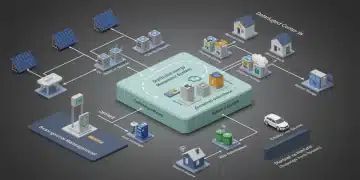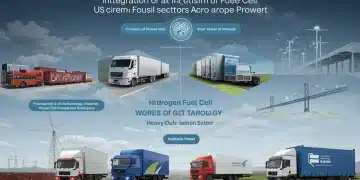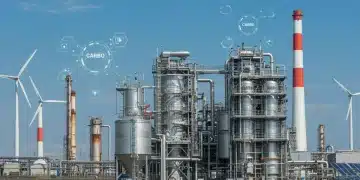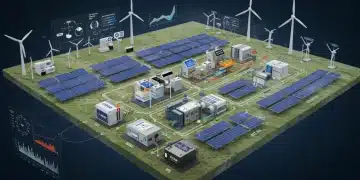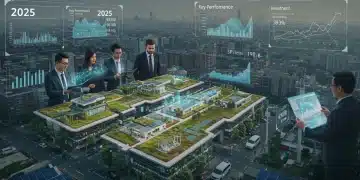Sustainable Transportation 2025: Next-Gen EV Charging Solutions

The landscape of sustainable transportation in 2025 is rapidly evolving, driven by innovations in electric vehicle charging, with four next-gen solutions poised to redefine infrastructure and user experience.
As we approach 2025, the imperative for sustainable transportation 2025 solutions intensifies, with electric vehicles (EVs) at the forefront of this global shift. Recent developments in EV charging technology are not just incremental updates; they represent foundational changes that promise to make electric mobility more accessible, efficient, and integrated into our daily lives. This report delves into four next-generation EV charging solutions that are currently shaping the future of sustainable transport.
Ultrafast Charging Networks: Redefining Speed and Accessibility
The demand for faster charging is a primary driver in EV infrastructure development. Ultrafast charging networks, capable of delivering hundreds of miles of range in minutes, are becoming a crucial component of sustainable transportation 2025 strategies. These networks are expanding rapidly, particularly along major transit corridors and urban centers, addressing range anxiety and accelerating EV adoption.
Recent announcements from industry leaders indicate significant investments in these high-power charging stations. Companies like Electrify America and IONITY are pushing the boundaries, deploying chargers that can exceed 350 kW, drastically reducing charging times. This allows for quicker turnarounds, making long-distance EV travel more comparable to traditional gasoline vehicle refueling.
Advancements in Battery Technology Integration
The effectiveness of ultrafast charging is intrinsically linked to advancements in EV battery technology. Newer battery chemistries and thermal management systems are designed to withstand higher charging rates without compromising battery health or longevity. This symbiotic relationship ensures that the charging infrastructure can be fully utilized.
- Improved Thermal Management: Advanced cooling systems prevent overheating during rapid charging, preserving battery integrity.
- Optimized Battery Architectures: New cell designs allow for faster ion movement, accommodating higher power input.
- Smart Charging Algorithms: Software optimizes charging curves based on battery state and temperature, maximizing speed safely.
These technological synergies are critical for the widespread success of ultrafast charging, ensuring that EVs can charge quickly and reliably, a cornerstone for sustainable transportation 2025.
Inductive Charging Systems: The Wireless Revolution
Wireless or inductive charging represents a significant leap forward in convenience and integration for electric vehicles. This technology eliminates the need for physical cables, allowing EVs to charge simply by parking over a designated pad. While still in nascent stages for widespread public deployment, pilot programs and recent breakthroughs suggest a promising future for inductive charging as a key element of sustainable transportation 2025.
Major automotive manufacturers and technology firms are actively investing in research and development for inductive charging. For example, recent trials in European cities have showcased dynamic inductive charging, where vehicles can charge while in motion on specially equipped roads. This innovation could revolutionize urban logistics and long-haul transportation, making scheduled stops for charging less frequent.
Seamless Integration into Urban Environments
Inductive charging offers aesthetic and practical advantages, particularly in urban settings. Charging pads can be seamlessly integrated into parking spaces, roads, and even garage floors, reducing clutter and improving urban aesthetics. This discreet integration aligns perfectly with smart city initiatives.
- Reduced Infrastructure Clutter: No visible cables or bulky charging stations, enhancing urban landscapes.
- Increased Convenience: Automatic charging initiation upon parking, simplifying the user experience.
- Enhanced Safety: Eliminates trip hazards and reduces exposure to electrical components in public spaces.
The prospect of charging without human intervention makes inductive systems highly attractive for autonomous vehicles and public transport fleets, paving the way for a more efficient and integrated sustainable transportation 2025 ecosystem.
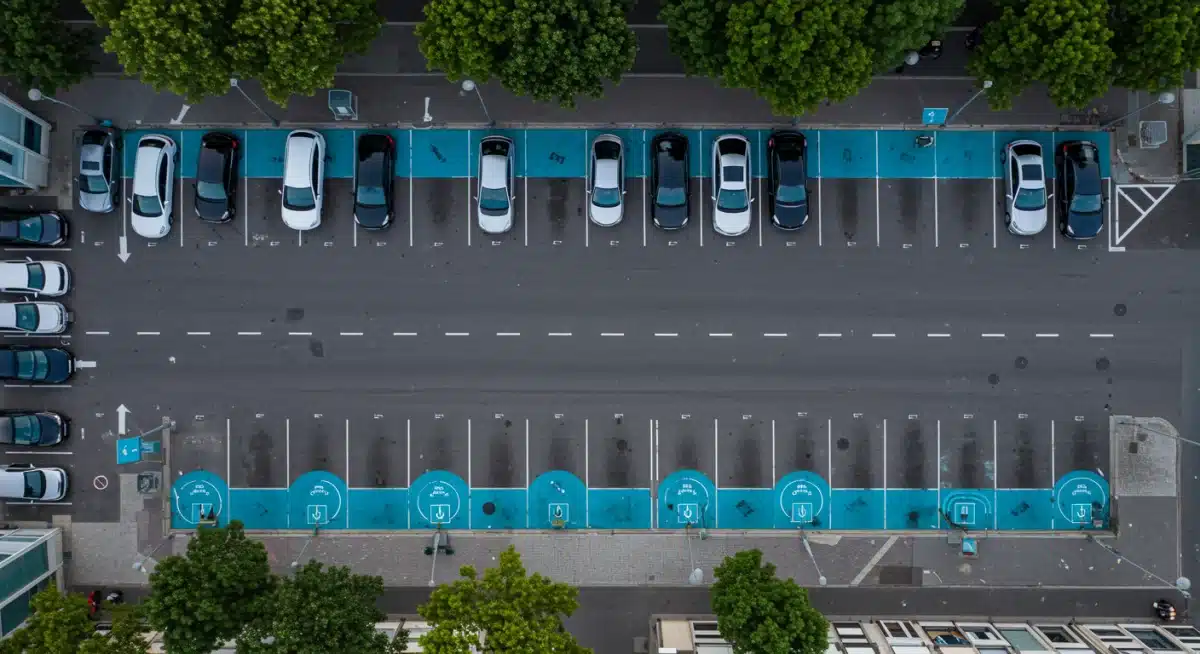
Vehicle-to-Grid (V2G) Technology: EVs as Power Hubs
Vehicle-to-Grid (V2G) technology is transforming electric vehicles from mere consumers of electricity into active participants in the power grid. V2G systems allow EVs to not only draw power from the grid but also feed electricity back into it during peak demand or when renewable energy sources are abundant. This bidirectional energy flow is a game-changer for grid stability and the integration of renewable energy, becoming a cornerstone of sustainable transportation 2025.
Several utility companies and automotive manufacturers are actively piloting V2G projects globally. Nissan, for instance, has been a pioneer with its Leaf model, demonstrating how parked EVs can help balance grid loads. These initiatives highlight the potential for EVs to act as distributed energy storage units, fostering a more resilient and sustainable energy infrastructure.
Benefits for Grid Stability and Renewable Energy
V2G technology offers substantial benefits beyond just charging vehicles. It enables a more flexible and robust energy system, crucial for managing the intermittency of renewable sources like solar and wind power. By discharging power during peak demand, EVs can reduce the strain on traditional power plants and lower overall energy costs.
- Grid Load Balancing: EVs can inject power during peak hours, preventing blackouts and reducing reliance on fossil fuel peaker plants.
- Renewable Energy Integration: Stores excess renewable energy, making intermittent sources more reliable.
- Financial Incentives for Owners: EV owners can earn revenue by selling excess stored energy back to the grid.
The widespread adoption of V2G technology will fundamentally alter how we perceive and utilize electric vehicles, positioning them as critical assets in achieving sustainable transportation 2025 and broader energy sustainability goals.
Battery Swapping Stations: Rapid Replenishment Solutions
Battery swapping technology offers an alternative to traditional charging by allowing EV owners to exchange a depleted battery for a fully charged one in a matter of minutes. This solution effectively eliminates charging times, providing an experience akin to refueling a gasoline car. While previously facing standardization challenges, recent innovations and strategic partnerships are revitalizing battery swapping as a viable and attractive option for sustainable transportation 2025.
Companies like NIO in China have successfully implemented extensive battery swapping networks, demonstrating its practicality and user acceptance. These stations are becoming increasingly automated, with robotic systems handling the battery exchange process efficiently. The model is particularly appealing for commercial fleets and ride-sharing services where vehicle downtime must be minimized.
Addressing Range Anxiety and Operational Efficiency
Battery swapping directly tackles range anxiety by providing instant full charge without waiting. It also offers operational benefits such as optimized battery maintenance and potential for battery upgrades without replacing the entire vehicle.
- Instant Full Charge: Eliminates waiting times associated with traditional charging.
- Optimized Battery Health: Centralized battery management at swapping stations ensures optimal charging and maintenance conditions.
- Future-Proofing Vehicles: Allows for easy battery upgrades as technology improves, extending vehicle lifespan.
The re-emergence and refinement of battery swapping technology underscore its potential to address key barriers to EV adoption, solidifying its role in the future of sustainable transportation 2025.
Smart Charging and Grid Integration: The Future of Energy Management
Smart charging goes beyond simply delivering power; it involves intelligent communication between the EV, the charging station, and the utility grid. This allows for optimized charging schedules based on electricity prices, grid demand, and renewable energy availability. As sustainable transportation 2025 objectives become more ambitious, smart charging is emerging as a critical tool for efficient energy management and grid stability.
Modern smart charging systems leverage AI and machine learning to predict energy needs and optimize charging patterns. For example, a vehicle might be scheduled to charge overnight when electricity rates are lower and renewable energy generation is high. This not only benefits the consumer through reduced costs but also supports the grid by smoothing out demand peaks.
The Role of AI and Data Analytics
Artificial intelligence and big data analytics are central to the effectiveness of smart charging. These technologies process vast amounts of information—from weather patterns affecting solar production to real-time grid conditions—to make intelligent charging decisions. The goal is to create a dynamic and responsive charging ecosystem that seamlessly integrates with renewable energy sources.
- Dynamic Pricing Integration: Charges when electricity is cheapest, reducing operational costs for EV owners.
- Grid Resilience: Helps balance supply and demand, preventing overloads and reducing the need for fossil fuel backup.
- Renewable Energy Maximization: Prioritizes charging during periods of high renewable energy output, reducing carbon footprint.
The sophistication of smart charging solutions is rapidly advancing, making them indispensable for a truly sustainable and efficient electric vehicle infrastructure by sustainable transportation 2025.
Policy and Infrastructure Development: Catalyzing Adoption
The rapid evolution of next-gen EV charging solutions is not solely driven by technological innovation; supportive government policies and robust infrastructure development play an equally critical role. As we look towards sustainable transportation 2025, governments worldwide are implementing incentives, regulations, and funding initiatives to accelerate the deployment of advanced charging networks and encourage EV adoption.
Recent legislative actions, such as the Bipartisan Infrastructure Law in the United States and various European Green Deal initiatives, allocate billions towards building a comprehensive national and regional EV charging infrastructure. These policies often include provisions for standardized charging protocols, interoperability, and equitable access to charging facilities, ensuring that the benefits of sustainable transportation reach all communities.
Global Collaboration and Standards
International collaboration is also vital in establishing global standards for EV charging, which can facilitate seamless travel across borders and ensure compatibility between different vehicle models and charging stations. Organizations like the International Electrotechnical Commission (IEC) are working to harmonize these standards, which is crucial for the global scalability of new charging technologies.
- Government Subsidies and Tax Credits: Incentivize both consumers to purchase EVs and businesses to install charging infrastructure.
- Zoning and Building Codes: Mandate EV charging readiness in new constructions, ensuring future-proof development.
- Public-Private Partnerships: Foster collaboration between governments and private sector companies to accelerate deployment.
These concerted efforts in policy-making and infrastructure build-out are foundational to realizing the full potential of next-gen charging solutions and achieving the ambitious targets for sustainable transportation 2025.
| Key Innovation | Brief Description |
|---|---|
| Ultrafast Charging | Delivers hundreds of miles of range in minutes, crucial for long-distance EV travel. |
| Inductive Charging | Wireless charging by parking over a pad, enhancing convenience and urban aesthetics. |
| V2G Technology | Allows EVs to feed electricity back to the grid, supporting stability and renewables. |
| Battery Swapping | Exchanges depleted batteries for full ones in minutes, eliminating charging wait times. |
Frequently Asked Questions About EV Charging in 2025
Ultrafast EV charging significantly reduces the time required to replenish an electric vehicle’s battery, often adding hundreds of miles of range in mere minutes. This addresses range anxiety, making long-distance EV travel more practical and comparable to traditional gasoline refueling, thereby accelerating EV adoption.
Inductive charging offers a cable-free, convenient method for EVs to charge by simply parking over a designated pad. This technology enhances urban aesthetics by reducing clutter, improves safety by eliminating cables, and streamlines the charging process, making it ideal for smart cities and autonomous vehicles.
V2G technology allows EVs to both draw power from and feed power back into the grid. This bidirectional flow helps stabilize the electricity grid during peak demand, integrates more renewable energy sources by storing excess power, and can offer financial incentives to EV owners, making EVs active energy participants.
Yes, battery swapping stations are becoming increasingly practical, especially for commercial fleets and ride-sharing services. They offer instant battery replenishment, eliminating charging wait times and providing an experience similar to traditional refueling. Innovations in automation and standardization are driving their renewed relevance.
Smart charging systems will optimize EV charging based on electricity prices and grid demand, leading to lower energy costs for owners and increased grid stability. By leveraging AI and data, they maximize the use of renewable energy, making the entire EV ecosystem more efficient and environmentally friendly.
Looking Ahead: Impact and Implications
These advancements in EV charging solutions are not merely technical improvements; they signify a fundamental shift in how we envision and implement sustainable transportation 2025. The convergence of ultrafast, wireless, V2G, and battery swapping technologies, coupled with smart grid integration, promises to create an electric mobility ecosystem that is more efficient, convenient, and environmentally benign. As governments and private sectors continue to invest and innovate, the coming years will likely see these solutions move from pilot programs to widespread adoption, fundamentally reshaping urban planning, energy infrastructure, and daily commutes. The ongoing developments will undoubtedly catalyze further EV adoption, significantly contributing to global climate goals.
